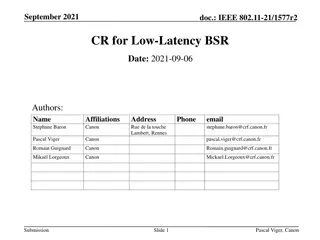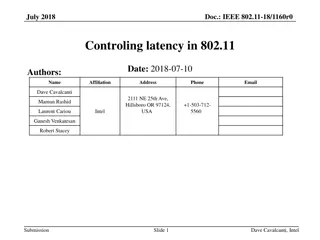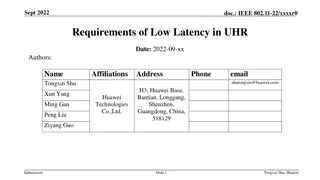IEEE 802.11-19/1942r1 Timing Measurement for Low Latency Features
The document discusses the necessity of measuring latency and jitter for IEEE 802.11be low-latency functions. It emphasizes the importance of precise measurement methods to evaluate quality and control low-latency features effectively. The presentation highlights the need for timing measurement to recognize or predict worst-case scenarios for real-time applications. It also explains time categorization for latency analysis in Wi-Fi Time Sensitive Networking.
Download Presentation

Please find below an Image/Link to download the presentation.
The content on the website is provided AS IS for your information and personal use only. It may not be sold, licensed, or shared on other websites without obtaining consent from the author.If you encounter any issues during the download, it is possible that the publisher has removed the file from their server.
You are allowed to download the files provided on this website for personal or commercial use, subject to the condition that they are used lawfully. All files are the property of their respective owners.
The content on the website is provided AS IS for your information and personal use only. It may not be sold, licensed, or shared on other websites without obtaining consent from the author.
E N D
Presentation Transcript
November 2019 doc.: IEEE 802.11-19/1942r1 Timing Measurement for Low Latency Features Date: 2019-11-XX Authors: Name Akira Kishida Yasuhiko Inoue Yusuke Asai Yasushi Takatori Kengo Nagata Affiliations Address NTT Phone email 1-1, Hikarinooka Yokosuka-Shi, Kanagawa 239- 0847, Japan +81-46-859-2093 akira.kishida.fs@hco.ntt.co.jp Submission Slide 1 Akira Kishida (NTT)
November 2019 doc.: IEEE 802.11-19/1942r1 Abstract According to EHT PAR [1], the scope of TGbe includes at least one mode of operation capable of improved worst case latency and jitter. To achieve the above scope of PAR, latency and jitter should be measured Quantitatively. As well as IEEE 802.11a/b/g/n/ac/ax, IEEE 802.11be will use unlicensed spectra, low-latency and jitter functions depend on the surrounding environments. Therefore, measurement of quality of low-latency and jitter is quite important. Direct measurement is one of the most precise methods to evaluate the quality. This presentation discusses necessity of measurement for IEEE 802.11be low- latency functions. IEEE 802.11v (already merged to IEEE 802.11-2016) defines timing measurement and fine timing measurement as parts of WNM (Wireless Network Management). However, WNM offers measurement functions only for medium access delay of successful transmission. In addition to medium access delay, contention time and retransmission time should be also measured for real-time applications (RTAs). Statistical measurement for worst case latency or jitter would be needed, which requires a number of measurement results. Submission Slide 2 Akira Kishida (NTT)
November 2019 doc.: IEEE 802.11-19/1942r1 Need for Features of Measurement RTA Report [2] indicates various use cases of real-time applications and their requirements. It should be clarified how much delay occurs in a BSS(s) to meet the requirement of corresponding RTA. From the perspective of network operator, low-latency features in IEEE 802.11be should be controlled based on the results of timing measurement. Timing measurement can offer recognition or prediction of Worst Case for RTA. For example, low-latency queue proposed in [3] can be utilized based on the results of timing measurement. Submission Slide 3 Akira Kishida (NTT)
November 2019 doc.: IEEE 802.11-19/1942r1 Time Categorization for Latency Analysis Wi-Fi Time Sensitive Networking (17/1734r1) [4] comprises packet delay as follows. Packet Delay = Queueing Delay + Packet Transmission Time Latency analysis for EHT (19/0762r1) [5] divides packet delay as follows. TW: Contention waiting time Time to transmit previously arrived packets TC: Contention time TR: Additional time for retransmission Time spent for failed transmission TTX: Transmission time for successful data frame and ACK Submission Slide 4 Akira Kishida (NTT)
November 2019 doc.: IEEE 802.11-19/1942r1 Time Categorization for Latency Analysis (cont d) This figure shows an example of divided time categories based on Latency analysis for EHT (19/0762r1) [5] Sending STA Recieving STA Queue in Contention start Previous transmission TW: Contention waiting time Backoff Time Busy for another transmission Initial transmission TC: Contention time Backoff (carry over) Transmission failed Backoff Time TR: Additional time for retransmission Contention for retransmission Busy for another transmission TW: Contention waiting time TC: Contention time TR: Additional time for retransmission TTX: Transmission time for successful data frame and ACK Backoff (carry over) TTX: Transmission time for successful data frame Successful data transmission and ACK and ACK Submission Slide 5 Akira Kishida (NTT)
November 2019 doc.: IEEE 802.11-19/1942r1 Existing Features of Timing Measurement: WNM WNM (Wireless Network Management) defined in IEEE 802.11-2016 establishes Timing Measurement / Fine Timing Measurement procedures. However, timing Measurement in WNM can measure only medium access delay of successful transmission (portion of TTX). TW: Contention waiting time TC: Contention time TR: Additional time for retransmission TTX: Transmission time for successful data frame and ACK Submission Slide 6 Akira Kishida (NTT)
November 2019 doc.: IEEE 802.11-19/1942r1 Timing Measurement procedure in WNM Timing Measurement is initiated by transmitting Timing Measurement Request frame. Timing Measurement frame and corresponding Ack frame are used to measure time difference between STAs. Timing Measurement frame is an Action frame. Measurement period Submission Slide 7 Akira Kishida (NTT)
November 2019 doc.: IEEE 802.11-19/1942r1 Scope of Timing Measurement in WNM Timing Measurement in WNM can measure only medium access delay of successful transmission (portion of TTX). Sending STA Recieving STA Previous transmission TW Backoff Time However, real time applications are greatly affected by contention time (TC) and retransmission time (TR). Contention time increases according to transmissions by other STAs. Retransmission affects immediately n increase of latency. Busy for another transmission TC Need to measure for RTA in IEEE 802.11be Backoff (carry over) Backoff Time TR Busy for another transmission Backoff (carry over) TT Additional function(s) to measure TC and TR will be needed in IEEE 802.11be. X Measurement period by timing measurement defined in WNM Submission Slide 8 Akira Kishida (NTT)
November 2019 doc.: IEEE 802.11-19/1942r1 Timing Measurement for IEEE 802.11be As explained, additional measurement functions that can measure contention time and retransmission time would be required. Statistical information about latency and jitter should be measured and notified to determine whether target RTA can be utilized or not. Statistical information: Average latency for certain period, worst case latency and jitter, et, al. Submission Slide 9 Akira Kishida (NTT)
November 2019 doc.: IEEE 802.11-19/1942r1 Conclusions To obtain more detailed availability of low-latency and jitter features, following functions should be discussed in TGbe. Additional function(s) to measure contention time and retransmission time. Additional function(s) to measure and notify statistical information about latency and jitter. Submission Slide 10 Akira Kishida (NTT)
November 2019 doc.: IEEE 802.11-19/1942r1 Strall Poll 1 Do you agree that measurements of contention time (TC) and retransmission time (TR) are useful for controlling low-latency features? Y: N: A: Need more Information: Submission Slide 11 Akira Kishida (NTT)
November 2019 doc.: IEEE 802.11-19/1942r1 Strall Poll 2 Should measurement function(s) for low-latency be continued to be discussed? Y: N: A: Need more Information: Submission Slide 12 Akira Kishida (NTT)
November 2019 doc.: IEEE 802.11-19/1942r1 References [1] 802.11/18-1231r1 EHT draft proposed PAR [2] 802.11/19-0006r6 RTA report draft [3] 802.11/19-1524r0 Latency enhancement for EHT [4] 802.11/17-1734r0 Wi-Fi Time Sensitive Networking [5] 802.11/19-0762r1 Latency analysis for EHT Submission Slide 13 Akira Kishida (NTT)























